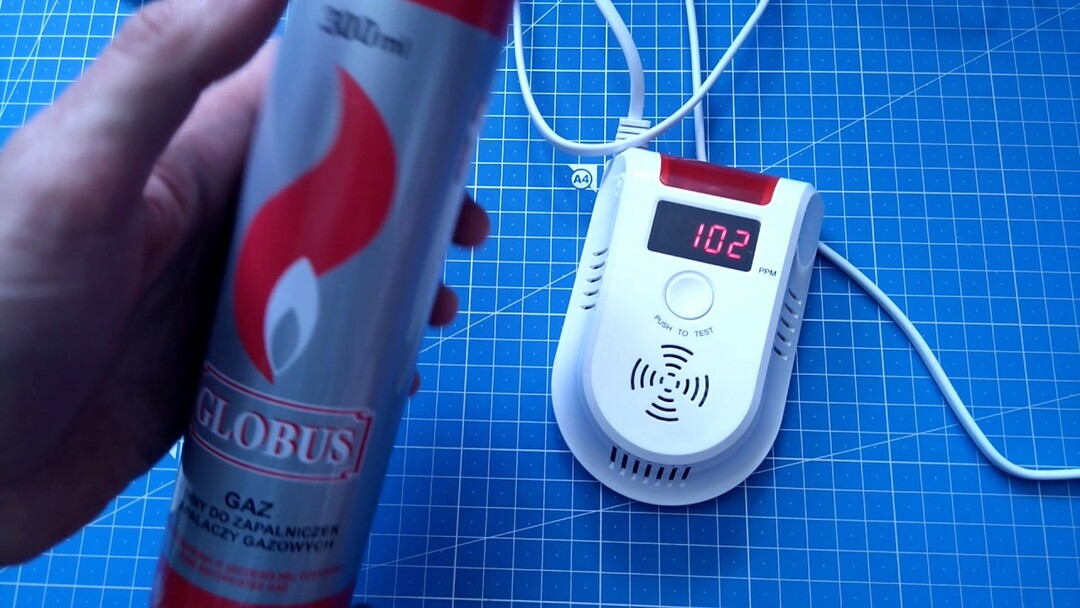Agree, the news that somewhere there was an explosion of a gas cylinder, which, unfortunately, we sometimes hear on TV or from friends, makes us think about our own safety. And complacency that this will not happen to us is out of place in this situation.
The consequences of such an explosion and the fire caused by it can be the most sad, and not only for property, but also for the health and life of people who find themselves nearby. We will help you understand why gas cylinders can explode, and how, without giving up the convenience of their use, protect yourself from big trouble.
For this, we conducted a study of the features of existing types of household gas vessels, analyzed the reasons for the explosions in a number of real-life cases, and the competent opinions of experienced users about this. The proposed article can be presented as a compilation of sets of rules in an easy-to-understand form that allows in practice to correctly and safely use gas in cylinders.
The content of the article:
-
The basics about gas cylinders
- Types of vessels for gas
- How does a balloon work?
- Gas mixture for household cylinders
-
Prerequisites for the explosion
- Explosion or combustion of gas
- Cylinder in the fire zone
- Excessive filling of the cylinder with gas
- Heating or cooling the walls of the vessel
- Blows and falls of cylinders
- Impurities in the gas
- Defect of a weld
-
Scenarios of the consequences of a balloon explosion
- Cylinder rupture and flame burst
- Secondary damaging effects from explosion
- Danger of gas leaks
- Basics of safe handling of cylinders
- Conclusions and useful video on the topic
The basics about gas cylinders
The indispensability of gas cylinders in everyday life can be confirmed with confidence by a significant part of the population of Russia.
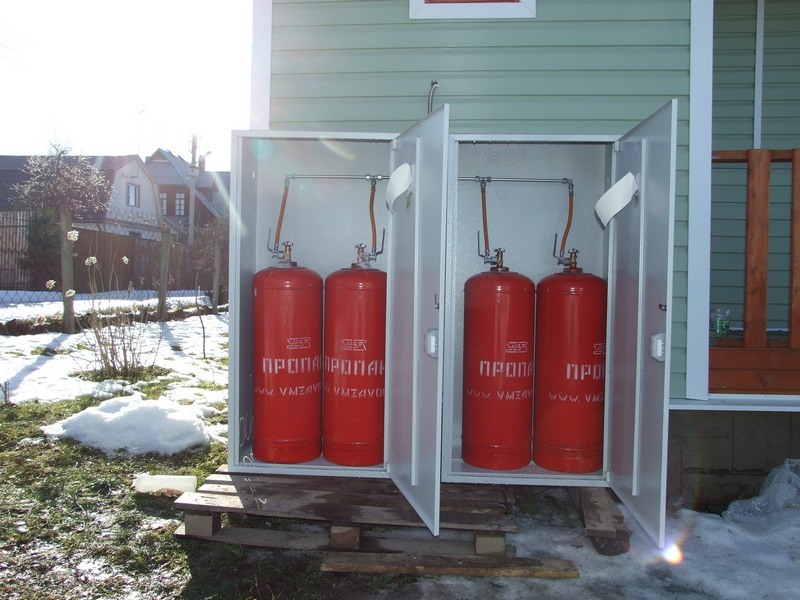
For many people, the use of liquefied gas cylinders is not just an opportunity to have additional conveniences in the country, but the only available option for gasification of their residential building.
At the state level, Rostekhnadzor has identified general problems in the use of gas vessels that you need to know about, since they are associated with their safe use:
- outdated fleet - about 90% of all cylinders are not protected from overfilling during refueling;
- lack of clear government regulation in the field of cylinder circulation on the market, which can include the presence of illegal refueling;
- the need to improve and bring the norms of technical parameters to international standards.
Non-compliance with these requirements and the recommendations of the European Commission imposes difficulties in ensuring the safety of gas-cylinder products used in Russia and imported.
In addition to knowing common problems, so that it is easier to imagine the reasons leading to the explosion, and the conditions that may contribute to this, it will be useful to know what cylinders exist, to deal with the device, to understand some of the nuances from the physics of explosion and combustion used in mixtures thereof.
Types of vessels for gas
Depending on the area of application, the filler used and the connection methods, gas vessels may differ both structurally and in the material of which the body is made.
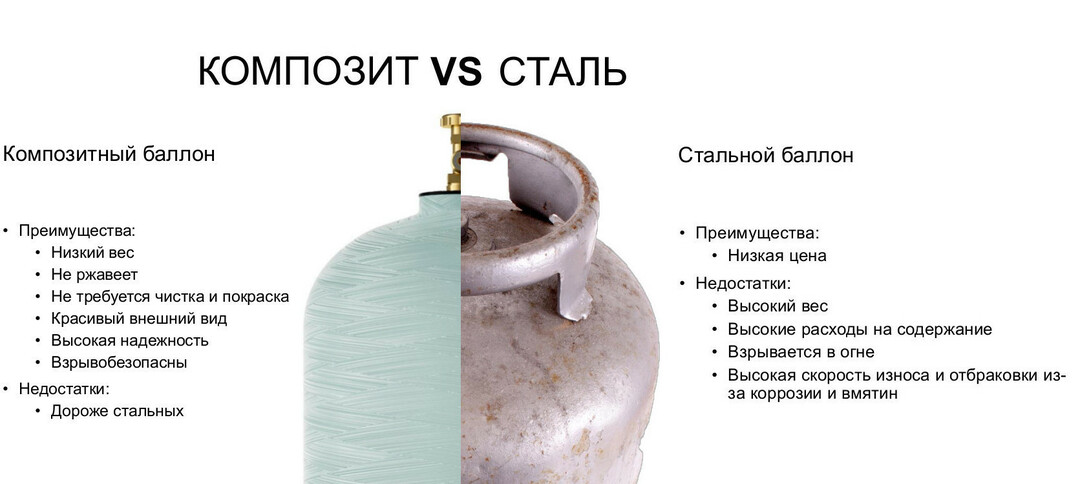
For domestic needs, as a rule, metal (steel) gas vessels or flasks made of composite materials are used. Each has its own pros and cons.
The most popular are metal cylinders, both new and old park vessels. The main reason for the increased demand for tanks of this type is their relatively low price and a large number of offers on the market, including due to containers made back in the Soviet time.
But it is steel cylinders that are subject to the greatest danger of explosion and, following safety principles, require compliance with a number of conditions during their storage and operation. Therefore, we will dwell on them in more detail.
How does a balloon work?
By design, the gas vessel resembles an ordinary lighter, the capacity of which is also filled with a substance in two states of aggregation. Part of the reservoir is occupied by gas in the liquid phase, the remaining free space is filled with the same substance, but in a gaseous (working) form. Through the shut-off device, the gas enters the appropriate equipment for ignition and intended use.
The standard complete set of a gas cylinder includes:
- The gas vessel itself or a shell, cylindrical in shape and with a minimum wall thickness of 2 mm.
- Balloon valve with shut-off element and flywheel.
- An annular support (shoe) that ensures a stable vertical position of the container with gas.
- A casing that protects the valve from damage and contamination during transportation, storage and operation.
A cap is attached to a special threaded part - the bottle neck ring.

A useful technically and in terms of safety device that can be equipped with gas cylinders is a propane reducer complete with a pressure gauge
Its use makes it possible to reduce, stabilize and maintain the pressure of the mixture at the values set for a particular gas consumer. This adapter can be easily installed on any kind of cylinders.
Gas mixture for household cylinders
The cylinders are filled with hydrocarbon gas - a mixture of propane and butane, which is pumped into a vessel under pressure up to 15 MPa.
The ratio of these hydrocarbons determines the seasonality of use of the mixture or a specific region. The fact is that with relatively identical basic properties, propane and butane have a significant difference in the values of evaporation temperatures: butane - 0.5 ° C, propane - 43 ° C (with a minus sign).
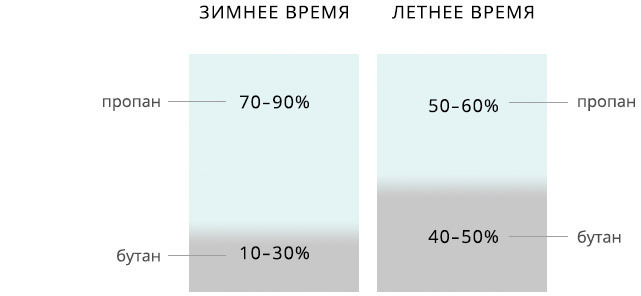
Due to the inexpediency of producing individual brands of bottled gas for each region, GOST provides for a unified propane-butane mixture with a certain percentage these gases
Knowledge of the principle of mixing the hydrocarbons used in gas reservoirs is essential not only in the possibility of reducing the cost of fuel (butane is cheaper propane), but also in a decrease, due to less intense evaporation of butane, the risk of the formation of increased pressure with a significant increase in the ambient temperature air. A sharp increase in pressure in the tank can cause its depressurization and, accordingly, an explosion or fire.
Prerequisites for the explosion
Despite the increasing requirements for the safe handling of cylinders and their quality, every year in Russia more than 200 people become fatal victims of balloon gas explosions, injured - by an order of magnitude more.
Summarizing the information of the manufacturers of gas containers, we give the pressure ranges at which the destruction of the flasks is possible:
| Gas bottle volume | Pressure at which an explosion is possible, MPa | Pressure at which an explosion is possible, atm |
| 5 l | 15-16 | 120-160 |
| 27 l | 7,5-13 | 75-130 |
| 50 l | 7,5-12 | 75-120 |
With a decrease in the strength of the walls of the flask, the critical value of the pressure, leading to its depressurization, decreases to 5.3 MPa.
Explosion or combustion of gas
You need to understand that the explosion and ignition of the cylinder are not exactly the same thing. For example, the question of whether a household gas cylinder that has received a fragmentation or bullet hole can explode cannot be answered unequivocally "yes".
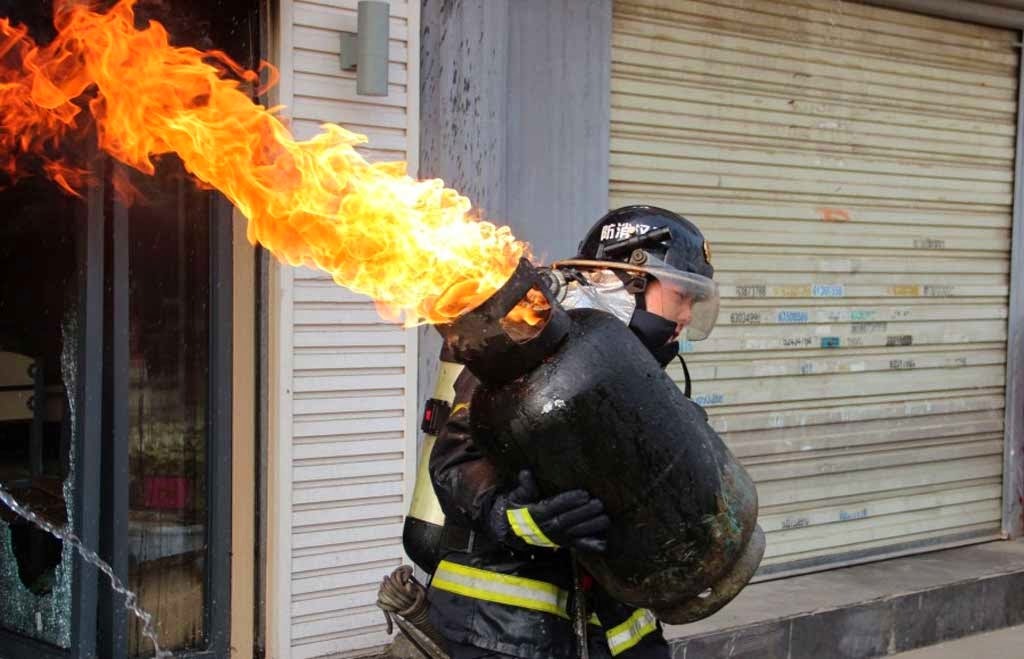
Gas escaping from a damaged pressure vessel will simply burn. An enclosed space is required for an explosion. This is, as a rule, the cylinder itself, under certain conditions, or a highly polluted room.
A mixture of propane-butane with oxygen explodes in the air outside the cylinder or drawn inward, after the pressure inside the flask equals atmospheric pressure.
What causes gas cylinders to explode or burn?
Cylinder in the fire zone
The explosion hazard of a container that has got into the combustion zone, with a gas mixture under pressure in it, is very high. According to GOST, the maximum safe temperature for a hydrocarbon cylinder is 45 ° C. It is clear that in the hearth of a fire, it significantly exceeds the permissible value.
The physics of the process is as follows. At a high heating temperature, the mixture in the vessel boils and, accordingly, the pressure in it rises. In addition, uneven heating of the shell surface weakens its initial strength and leads to the destruction of the walls.
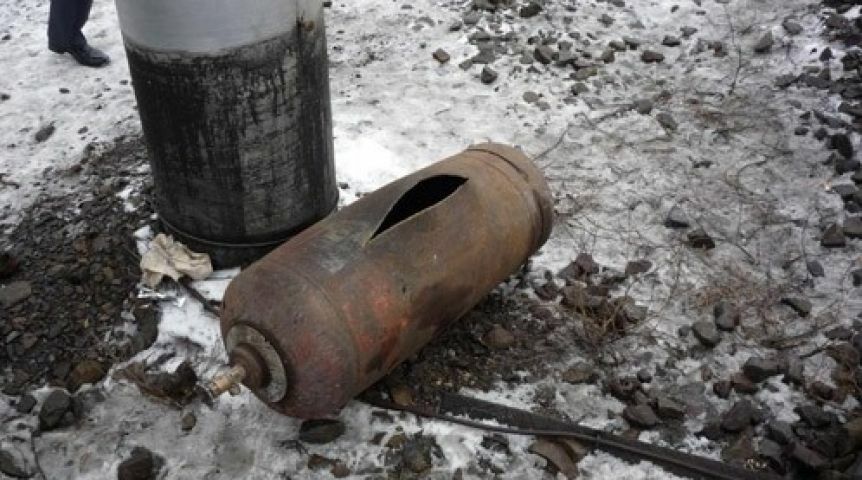
Usually, due to the high residual plastic deformation of the vessel with gas and its heating from one side, a local swelling of the wall (otulina) occurs. Rupture more often occurs along the weld
Rapidly evaporating and igniting, the hydrocarbon ejected from the cylinder in a liquid and vapor state has an additional thermal effect in the fire zone on everything around.
Having understood why gas cylinders explode during a fire in houses, you should also know how they can behave when heated.
There are two options for breaking the flask:
- On "hydraulic" mechanics.
- Severe twisting and large cracks in the bottom and shell.
In the first case, the liquid phase, with an increase in temperature to 60 ° C, will fill the volume of the vessel to the norm of 85% at a pressure of 1.5 - 2.5 MPa. The destruction of the shell will occur with a further increase in the temperature in the room to 70 - 75 ° C.
The second option takes place in the absence of a liquid phase in the vessel, if, for example, the evaporation of a liquefied mixture was due to depressurization of the locking device, at elevated temperatures under conditions fire.
In any scenario, fragments of an exploded balloon can fly away at high speed in different directions, creating a threat of injury to a person and damage to property.
Excessive filling of the cylinder with gas
Often filling tanks with liquefied gas, they overfill. This is due to negligence or deliberately, wanting to save on the utilization rate of the tank.
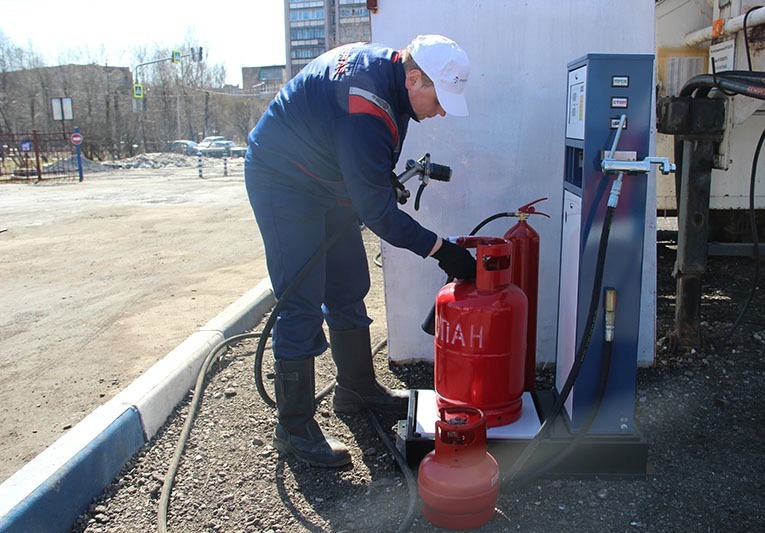
It should be understood that exceeding the pressure of the liquefied gas in the flask during refueling above the permissible level may cause a violation of its strength
A part of the free volume should remain in the tank - a pillow for the vapor phase of hydrocarbons. The safe volume of such a pillow is at least 15% of the total volume of the tank. In its absence, the pressure in the flask increases by 0.7 MPa with an increase in the temperature of the mixture for each degree, which is unacceptable according to safety standards and can lead to overvoltage of the shell, and its break.
The amount of gas pumped into the vessel is strictly regulated in terms of pressure and mass, and should not exceed 0.425 kg per 1 liter of tank volume.
Even at the temperature of +45 ° C stipulated by GOST, an overfilled flask poses a great danger of the likelihood of longitudinal rupture along the weld.
We also recommend reading our other article, where we talked in detail about the rules refueling gas cylinders.
Heating or cooling the walls of the vessel
A propane-butane mixture, having a high coefficient of expansion, even with a slight increase in its temperature, greatly increases in volume.
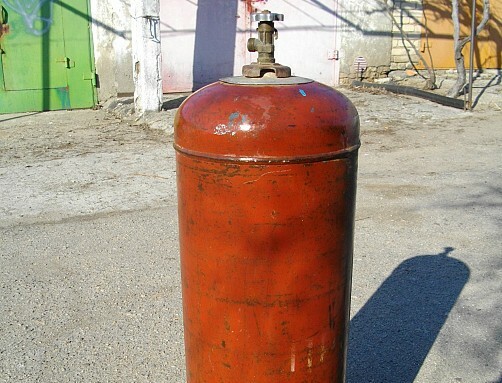
Increasing the pressure in the cylinder to a critical value is possible when the vessel is heated for a long time in the sun, under direct rays
The danger of an increase in the pressure of the mixture on the walls of the flask also exists in the cylinder installed next to the heat source.
In addition to heating, a number of dangers are also fraught with the negative effects of negative temperatures. The first is an increase in the brittleness of the metal. And the second - it is necessary to remember forever that in no case should a vessel, which has been in the cold, be brought into a warm room for a long time. A sharp rise in the temperature of the hydrocarbon mixture is unsafe.
Blows and falls of cylinders
Sharp mechanical impacts on it can provoke damage and ignition of the vessel with gas. walls, especially when the tank is in conditions of low or, conversely, too high temperatures.
When using a cylinder in abnormally cold conditions, the mechanical properties of the metal change - the impact toughness of steel decreases.
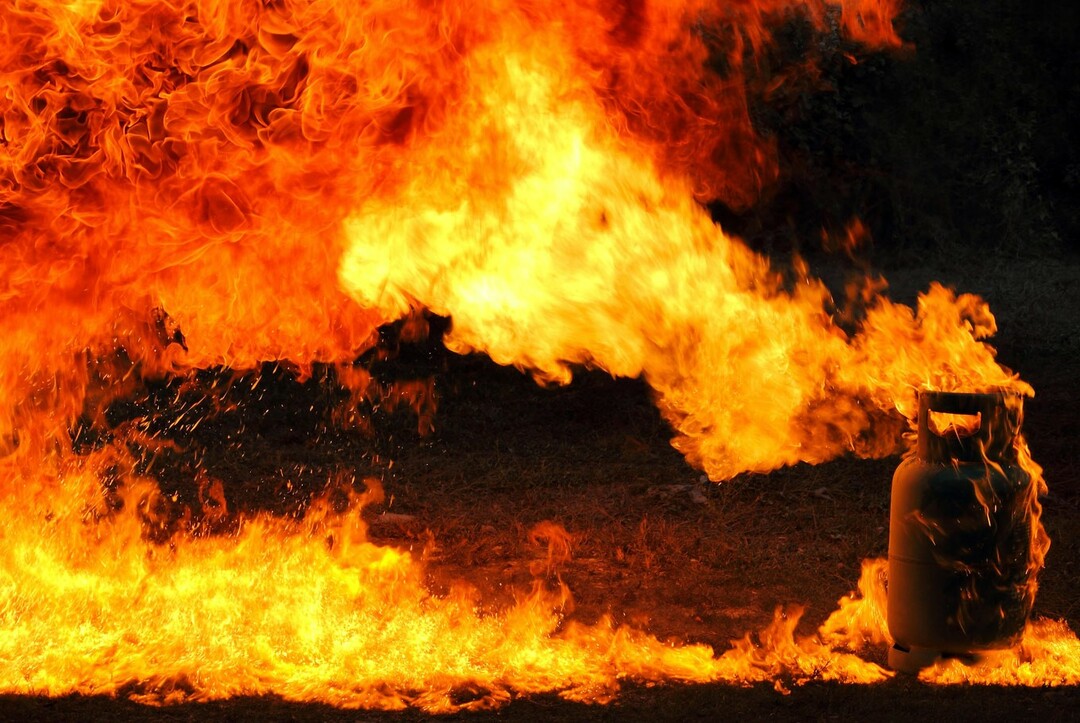
For this reason, a strong impact on the cylinder or its hard fall can damage the tightness of the vessel and promote the release of gas, which, in a mixture with oxygen and upon contact with a spark, will lead to detonation of the gas mixture with air
In the second case, an increase in temperature and heating of the gas contained in the flask, as it was said, sharply increases its pressure, which, with additional shock effects on the vessel, can rupture his.
Impurities in the gas
The danger of explosion lurks if water and hydrogen sulphide enters the vessel with liquid gas. Their high content in the tank contributes to the appearance of delaminations and flaws on the inner metal surface of the shell.
Such defects of vessels occur when there is hydrogen sulfide in propane of 0.3% or more, and can be observed after a two-year period of using the cylinder.
Defect of a weld
Less often, but there are problems associated with depressurization of vessels with gas in the near-weld zone.
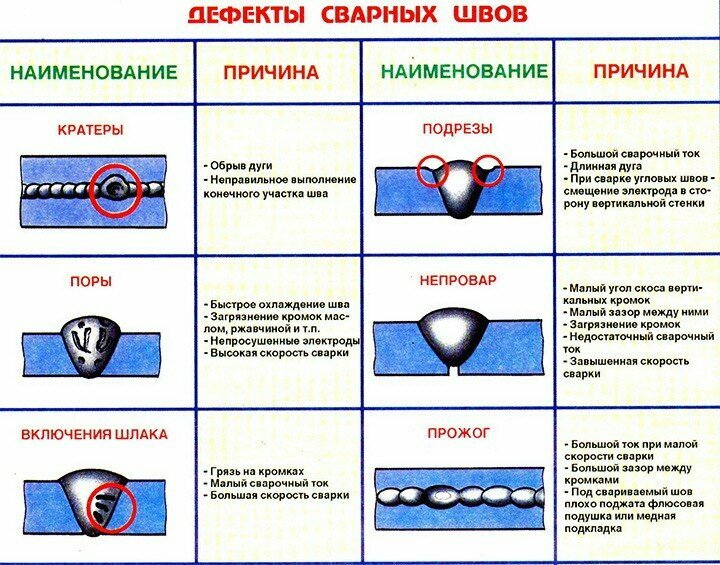
In the event of a weld seam defect, a weakening of its working section, stress concentration and, as a result, opening of longitudinal or circular seams can occur.
The overall integrity of the shell may be retained when a defective weld breaks.
Scenarios of the consequences of a balloon explosion
The above reasons for the explosion or ignition of gas vessels can, in various ways, provoke the following hazardous scenarios.
Cylinder rupture and flame burst
The explosion of the cylinder and the ignition of propane-butane are dangerous due to the influence of the following factors:
- a column of strong flame, rapidly increasing the area of the fire;
- high temperature of fire in the center of explosion;
- toxicity of combustion products.
The defeat can occur from suffocation, due to a significant decrease in oxygen with a sharp concentration of harmful gases.

The studies carried out have shown that the sealing of a 50-liter gas vessel with liquefied gas caught in a fire breaks down in less than 5 minutes. As a result - a fire-flash with the release of a "fireball" reaching a diameter of 10 m
Usually the rupture of the vessel occurs along its lateral part.
Secondary damaging effects from explosion
Secondary, but no less serious damaging consequences in the explosion of a cylinder, are:
- valve separation;
- the impact of a compression wave or shock wave;
- damage from fragments of shell elements.
Debris from the balloon and its detached elements can fly very far, inflicting damage within a radius of up to 250 m, and rise to a height of thirty meters.
Danger of gas leaks
The danger of propane leaking from a damaged container is that in a room very quickly, and in large volumes, an explosive concentration of a mixture of hydrocarbon and oxygen is created - much faster than with leaks of liquid fuels substances.
A strong leakage of a mixture from a flask or a faulty shut-off valve can be determined by smell or by ear - the sound is similar to what we hear when a balloon is quickly deflated.
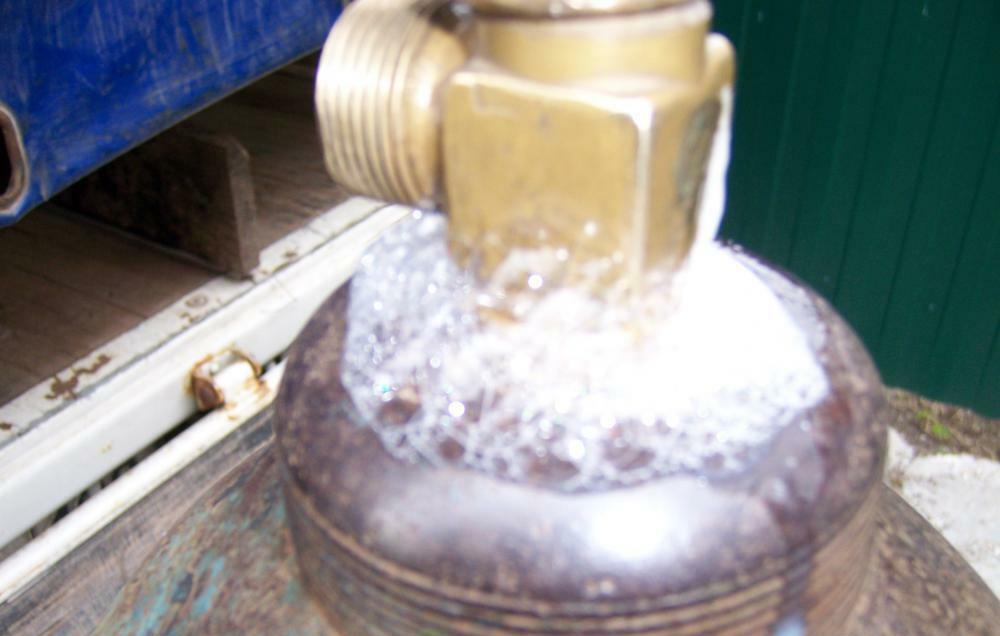
If you suspect a gas leak or in order to control its absence, it will be enough to apply a soap solution to the cylinder with a sponge and determine the place of depressurization by the bubbles formed.
If there is a gas leak, then it is necessary to cover the place of depressurization with a wet rag, carefully take the vessel out into the street and call the gas workers.
Since 2016, the technical rules have provided for the mandatory installation of gas alarms in new homes. For previously built housing, this norm is advisory in nature, but the benefits of this device, especially in houses where bottled gas is used, are beyond doubt.
The fact is that the density of the hydrocarbon mixture is greater than the density of air. If the sealing of the flask, shut-off equipment or connecting hose is broken, the gas begins to accumulate at the bottom, and its smell may not be immediately detected. This is why a propane mixture released into the air from a damaged gas cylinder often explodes in homes from any spark without being noticed.
Basics of safe handling of cylinders
Before installing the cylinder and connecting it to gas appliances the first thing to do is to make sure that there is no damage, rust on the body and the valve is in good working order.
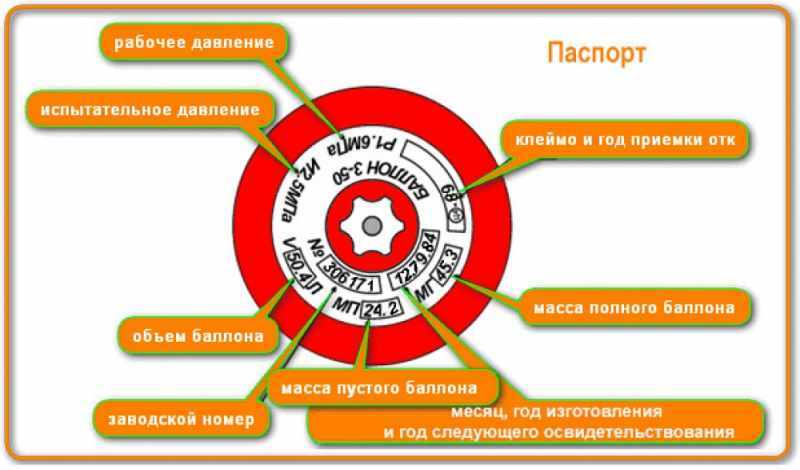
Only certified cylinders supplied by specialized organizations with paper passport for all cycles of operation and the corresponding marking applied by the impact method branding
The main technical requirements that must be observed during the operation of cylinders include:
- All cylinders, with the exception of one (five-liter for connection to a gas stove), must be installed in outbuildings outside buildings and at a distance not closer than 5 m from the entrance to them.
- Exclude storage of cylinders in living rooms, basements and attics.
- Do not place cylinders closer than 1 m from heating devices and 5 m from open flames.
Obvious, but often forgotten safety measures when using vessels with gas, the following should be attributed and taken to strict implementation:
- Do not put a lighted match or lighter near the cylinder in order to check for gas leaks.
- The use of open flames to warm up the gearbox or valve is strictly prohibited. For these purposes, only hot water is allowed.
- If gas is detected in the room, do not turn on any electrical appliances, including lights, and do not turn them off. The spark temperature in a socket or switch can reach thousands of degrees.
- Do not try to repair shut-off valves and other structural elements of the cylinder on your own.
In addition, it is necessary to strictly follow the manufacturer's prescribed time frames for the use of cylinders. Vessels manufactured before December 2014 can be operated for 40 years.
In the absence of information about the permitted period of use of gas cylinders produced after this date and not having accompanying documentation to them, Rostekhnadzor recommends taking for the expiration date of the cylinder - 20 years old.

It is absolutely impossible to carry gas cylinders using the valve as a holding device. This can cause depressurization or breakage of the shut-off device.
A safe alternative to steel gas cylinders are more modern polymer-composite vessels - euro cylinders. Their flasks are protected by a plastic casing, do not accumulate static electricity. Explosion safety of composite cylinders is ensured by equipping them with a new generation of safety devices - a fusible link and an overpressure relief check valve.
Conclusions and useful video on the topic
The reasons for the explosions of gas cylinders on examples of real facts, and what can and cannot be done when using them:
How to properly use gas cylinders in everyday life, and what requirements they must meet:
With all the existing risk factors accompanying the operation of gas equipment, there is no reason to succumb to fear and refuse the convenience of using them in everyday life.
Theoretical knowledge of the causes and conditions accompanying the explosion of household gas cylinders is designed to help in overcoming this fear. And compliance with the above set of standards for their safe use will serve as reliable insurance against the severe consequences of a gas explosion and fire.
If you have valuable information that can supplement our material, please share it with other site visitors - leave your comments in the block below. There you can also ask questions of interest on the topic of the article.


